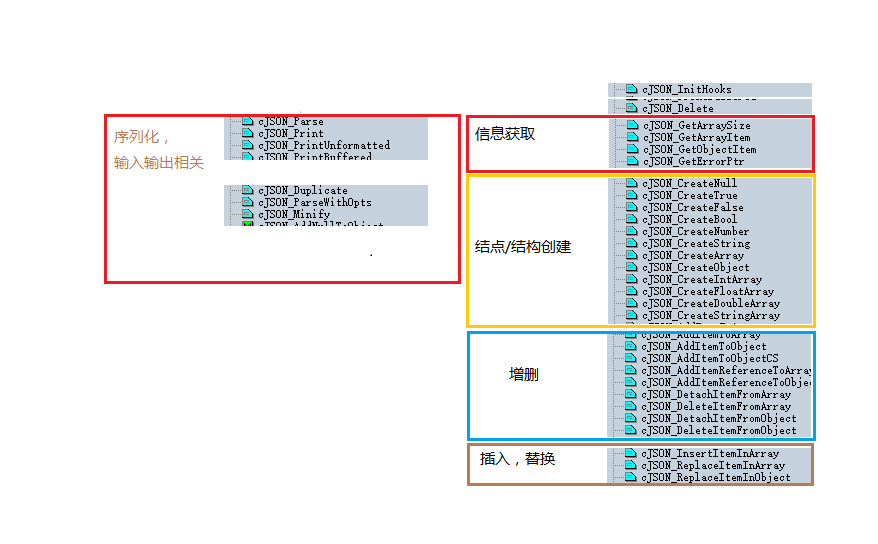cJSON简介
JSON基本信息
JSON(JavaScript Object Notation)是一种轻量级的数据交换格式。易于人阅读和编写。同时易于机器解析和生成。是一种很好地数据交换语言。
JSON构建:基于两种结构
“名称/值”对 的集合。
值得有序列表。
JSON具体结构表示
对象:一个”名称/值"对的集合 {名称:值,名称:值}
数组:值得有序集合[值,值]
值:str,num,true,false,null,object,array。可嵌套
字符串:由双引号包围的任意数量Unicode字符的集合,反斜杠转义
数值:类似C,java:没有8进制和具体的编码细节
cJSON源码解读
首先给出cJSON文件中头文件函数列表
我们将根据此进行模块化解读

①结构描述
关于具体的结构图解描述,请参考官方描述
/* cJSON Types: */ #define cJSON_False 0 #define cJSON_True 1 #define cJSON_NULL 2 #define cJSON_Number 3 #define cJSON_String 4 #define cJSON_Array 5 #define cJSON_Object 6 #define cJSON_IsReference 256 #define cJSON_StringIsConst 512
以上是具体的类型区分描述,可以改进为使用enum实现更加安全
/* The cJSON structure: */ typedef struct cJSON { struct cJSON *next, *prev; /* 如果是同一级别类型元素,使用双项链方式实现 */ struct cJSON *child; /* 如果是具体结构或者数组,第一个指针指向内部链 */ int type; /*根据以上定义描述所保存对象类型*/ char *valuestring; /* The item's string, if type==cJSON_String */ int valueint; /* The item's number, if type==cJSON_Number */ double valuedouble; /* The item's number, if type==cJSON_Number */ char *string; /* 对于key-value映射结构,表示其key/名称 */ }cJSON;
②关于内存管理
typedef struct cJSON_Hooks { void *(*malloc_fn)(size_t sz); void(*free_fn)(void *ptr); } cJSON_Hooks;
注:cJSON的内存管理,提供了用户自主方式的接口。可以通过方法InitHooks来设置自己的内存管理,默认使用malloc,free
static void *(*cJSON_malloc)(size_t sz) = malloc; static void(*cJSON_free)(void *ptr) = free; void cJSON_InitHooks(cJSON_Hooks* hooks) { if (!hooks) { /* Reset hooks */ cJSON_malloc = malloc; cJSON_free = free; return; } cJSON_malloc = (hooks->malloc_fn) ? hooks->malloc_fn : malloc; cJSON_free = (hooks->free_fn) ? hooks->free_fn : free; }
③结点创建,删除结点
/* Internal constructor. */ static cJSON *cJSON_New_Item(void) { cJSON* node = (cJSON*)cJSON_malloc(sizeof(cJSON)); if (node) memset(node, 0, sizeof(cJSON)); return node; } /* Delete a cJSON structure. */
//删除节点很简单, 先删除儿子,然后清理内存即可。
//总结一下就是对于 object 和 array 需要先删除儿子,然后删除自己。
//对于 字符串, 需要先释放字符串的内存, 再释放自己这块内存。
//对于其他节点,直接释放自己这块内存。
void cJSON_Delete(cJSON *c) { cJSON *next; while (c) { next = c->next; if (!(c->type&cJSON_IsReference) && c->child) cJSON_Delete(c->child); // if (!(c->type&cJSON_IsReference) && c->valuestring) cJSON_free(c->valuestring); if (!(c->type&cJSON_StringIsConst) && c->string) cJSON_free(c->string); cJSON_free(c); c = next; } }
有了结点设置,那么下面就是具体类型结点的实现了:设置类型,设置具体类型的值
/* These calls create a cJSON item of the appropriate type. */ extern cJSON *cJSON_CreateNull(void); extern cJSON *cJSON_CreateTrue(void); extern cJSON *cJSON_CreateFalse(void); extern cJSON *cJSON_CreateBool(int b); extern cJSON *cJSON_CreateNumber(double num); extern cJSON *cJSON_CreateString(const char *string); extern cJSON *cJSON_CreateArray(void); extern cJSON *cJSON_CreateObject(void); /* These utilities create an Array of count items. */ extern cJSON *cJSON_CreateIntArray(const int *numbers, int count); extern cJSON *cJSON_CreateFloatArray(const float *numbers, int count); extern cJSON *cJSON_CreateDoubleArray(const double *numbers, int count); extern cJSON *cJSON_CreateStringArray(const char **strings, int count);
/* Create basic types: */ cJSON *cJSON_CreateNull(void) { cJSON *item = cJSON_New_Item(); if (item) item->type = cJSON_NULL; return item; } /* Create Arrays: */ cJSON *cJSON_CreateIntArray(const int *numbers, int count) { int i; cJSON *n = 0, *p = 0, *a = cJSON_CreateArray(); for (i = 0; a && i < count; i++) { n = cJSON_CreateNumber(numbers[i]); //申请N个几点 if (!i) a->child = n;//第一个结点链接使用child else suffix_object(p, n);//其他结点 :连接prev next p = n; }return a; }
④结点操作
/* Append item to the specified array/object. */ extern void cJSON_AddItemToArray(cJSON *array, cJSON *item); extern void cJSON_AddItemToObject(cJSON *object, const char *string, cJSON *item); extern void cJSON_AddItemToObjectCS(cJSON *object, const char *string, cJSON *item); /* Use this when string is definitely const (i.e. a literal, or as good as), and will definitely survive the cJSON object */
/* Append reference to item to the specified array/object. Use this when you want to add an existing cJSON to a new cJSON,
but don't want to corrupt your existing cJSON. */ extern void cJSON_AddItemReferenceToArray(cJSON *array, cJSON *item); extern void cJSON_AddItemReferenceToObject(cJSON *object, const char *string, cJSON *item); /* Remove/Detatch items from Arrays/Objects. */
//Detatch脱离,使item从arr链中脱离,便于delete
extern cJSON *cJSON_DetachItemFromArray(cJSON *array, int which); extern void cJSON_DeleteItemFromArray(cJSON *array, int which); extern cJSON *cJSON_DetachItemFromObject(cJSON *object, const char *string); extern void cJSON_DeleteItemFromObject(cJSON *object, const char *string); /* Update array items. */ extern void cJSON_InsertItemInArray(cJSON *array, int which, cJSON *newitem); /* Shifts pre-existing items to the right. */ extern void cJSON_ReplaceItemInArray(cJSON *array, int which, cJSON *newitem); extern void cJSON_ReplaceItemInObject(cJSON *object, const char *string, cJSON *newitem);
注:①
Detach 是什么东西呢?
我们把一个节点从 json 树中删除, 但是不释放内存,而是先保留这个节点的指针, 这样储存在这个节点的信息都保留了下来。
接下来我们就可以做很多事了, 合适的时候添加到其他对象中, 合适的时候释放内存。
比如上面的 delete 函数, 就需要真实的删除了, 这个时候我们删除即可。
而 detach 实现也比较简单, 只是少了一步删除操作。
//将结点从结构中脱离 cJSON *cJSON_DetachItemFromArray(cJSON *array, int which) { cJSON *c = array->child; while (c && which>0) c = c->next, which--; if (!c) return 0; if (c->prev) c->prev->next = c->next; if (c->next) c->next->prev = c->prev; if (c == array->child) array->child = c->next; c->prev = c->next = 0; return c; } void cJSON_DeleteItemFromArray(cJSON *array, int which) { cJSON_Delete(cJSON_DetachItemFromArray(array, which)); }
②关于以上相关方法,简单的增加结点就是个链表操作了,然后对于
cJSON_AddItemReferenceToArray这个方法说明
cJSON除了实现简单的增加结点到结构之外,还有简单考虑效率问题。
比如同时增加一个结点到两棵树中,那么如果有深浅拷贝问题时,cJSON做法是,增加一个结点为Reference类型,在另一棵树中。这里的做法可以是引用计数,写实拷贝等
我们来看看cJSON实现吧
/* Utility for handling references. */ static cJSON *create_reference(cJSON *item) { cJSON *ref = cJSON_New_Item(); if (!ref) return 0; memcpy(ref, item, sizeof(cJSON)); //浅拷贝所有值-->最终保存了结点的value部分 ref->string = 0; //k-v中的值清空,以便于重新设置 ref->type |= cJSON_IsReference; //结点类性是具体item类型的同时也是reference ref->next = ref->prev = 0; //只是当前节点的引用,去除引用的链接 return ref; } void cJSON_AddItemReferenceToArray(cJSON *array, cJSON *item) { cJSON_AddItemToArray(array, create_reference(item)); //创建应用结点之后加入目的数组 }
void cJSON_ReplaceItemInArray(cJSON *array, int which, cJSON *newitem) { cJSON *c = array->child; while (c && which>0) c = c->next, which--; //找到具体位置 if (!c) return; newitem->next = c->next; newitem->prev = c->prev; //连入结构中 if (newitem->next) newitem->next->prev = newitem;//修改后指针 if (c == array->child) //如果是个孩子, array->child = newitem; else newitem->prev->next = newitem; //修改后指针 c->next = c->prev = 0;//释放被代替的结点 cJSON_Delete(c); }
⑤查找相关
/* Get Array size/item / object item. */ int cJSON_GetArraySize(cJSON *array) { cJSON *c = array->child; int i = 0; while (c) i++, c = c->next; return i; } cJSON *cJSON_GetArrayItem(cJSON *array, int item) { cJSON *c = array->child; while (c && item>0) item--, c = c->next; return c; } //结构中结点的设置,需要通过变量名来查找 cJSON *cJSON_GetObjectItem(cJSON *object, const char *string) { cJSON *c = object->child; while (c && cJSON_strcasecmp(c->string, string)) c = c->next; return c; }
⑥总结部分:
通过以上对于cJSON结构的简单学习和剖析,我们不难联想到广义表。其实这个结构的实现就是类似广义表实现:由child递归为广义结构
关于具体的cJSON数据解析部分,请参考博客《cJONS序列化工具解读②(数据解析)》